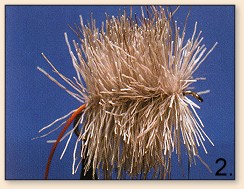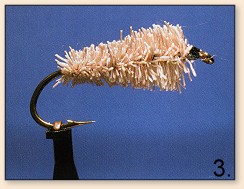Clark's Deer Hair Nymph
By Sheldon Seale
In 1929, Gregory Clark Sr., then in his mid-thirties,
was trying rather unsuccessfully to fish a "deer hair"
streamer on the Mad River in South Central Ontario.
According to his fishing diaries, the fly was
completely unsuccessful until he took some
scissors to it and cut it down into a scruffy
looking mess. At that point, it proved very
successful indeed. So much so, that master fly
tyers of the time, such as Sutton and Alcock,
were soon tying and selling them vigorously -
some claim by the thousands.
Some 10 to 12 years later, an American by the
name of Paul Young popularized an identical-looking
pattern named the Strawman. In the 1941 edition
of George Herter's Professional Fly Tying
and Tackle Making Manual and Manufacturer's Guide,
Herter describes the pattern as having "originated
in Canada". It is my contention that this was simply
a renaming of Clark's Deer Hair Nymph.
Greg Clark Sr. passed on to The Great Fishing Club
in the Sky in 1977, so we can't ask him to verify
this. Thankfully, his son, Greg Clark Jr., is still
with us and it is from him that we get the details
of this pattern. The method of tying is also of
interest to those of us who like to get things
historically accurate. According to Greg Jr.,
the tie involves "simply putting chunks of deer
hair in a spinning loop, giving it a spin, wrapping
the mess around a hook shank, and then clipping to
shape". This makes it one of the earliest references
to using deer hair in a spinning loop that I can find.
There are a number of theories explaining why Clark's
Deer Hair Nymph has been and continues to be a very
effective fly. Some believe that it successfully
imitates the cases of certain species of caddis
flies that are often associated with slack water.
Yet this pattern was originated on a river (and
the Mad River doesn't get its name for being calm
and placid!). According to Greg Jr., the fly can
be fished in lakes and ponds by "creeping it slowly
along the bottom with a sinking line". He also
claims that the Deer Hair Nymph is one of those
flies "for all seasons", for still or fast water,
and especially in "the heat of summer or for that
matter, any time the fishing is slow".
Recently, tyers have been experimenting with caddis
patterns tied to imitate caddis cases with the head
of the larva sticking out at the front They look
remarkably like Clark's Deer Hair Nymph with the
front end of a caddis larva at the head. The
Peeking Caddis is one of these. However, in my
experience, when these caddis larvae are crawling
slowly along the bottom, all you really see moving
is the case. In any case, the fish eat the larvae -
case and all. Consequently, the additional components
ascribed for the Peeking Caddis are not, in my
opinion, absolutely necessary. The Deer Hair Caddis,
which is a much simpler tie, performs just as well.
The original pattern is simplicity itself - deer
hair spun on a hook using a spinning loop, with a
floss ribbing (more for reinforcement, I suspect),
and then clipped to shape.
Recipe
Hook: 3X or 4X long, sizes 6-10.
Thread: Black 6/0.
Rib: Floss - yellow (the original, I believe),
brown, orange or red.
Body: Deer hair spun on in a spinning loop
and clipped to shape.
Head: Black thread.
The Strawman is essentially the same, except for
the inclusion of a tail of barred grey mallard flank.
Tying Steps

1. Put down a layer of thread, attach the ribbing,
and prepare a dubbing loop at the hook bend.

2. Clip deer body hair from a patch, comb out the
fuzz at the base and distribute it into the dubbing.
Spin the hair with the help of a dubbing spinner
until it forms a brush. Wrap the brush forward
in touching turns until you reach a point just
back from the hook eye (this may require that you
build a second dubbing loop and repeat this step).

3. Wrap the rib (or you may wait until after
clipping the body to shape), wiggling the floss
from side to side so it doesn't trap down too
much hair. Secure the rib and tie off. Clip
the body to shape.
 There it is - simplicity itself! It's an easy tie,
constructed from inexpensive materials that are
abundantly available. Pure Canadian elegance, eh?
~ Sheldon Seale
There it is - simplicity itself! It's an easy tie,
constructed from inexpensive materials that are
abundantly available. Pure Canadian elegance, eh?
~ Sheldon Seale
Credits: This article is from the
Canadian Fly Fisher magazine. We appreciate use permission!
Our Man In Canada Archives
|

